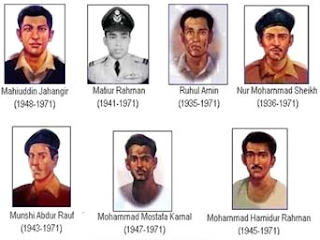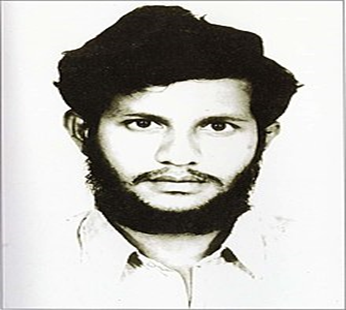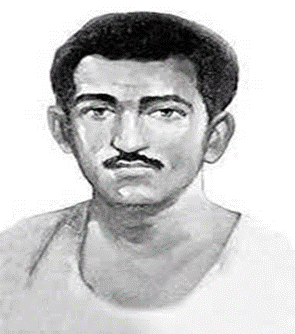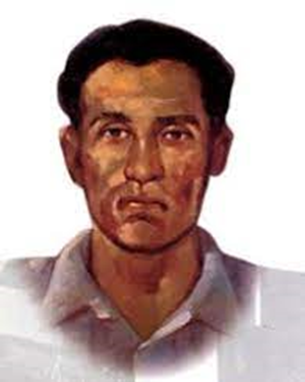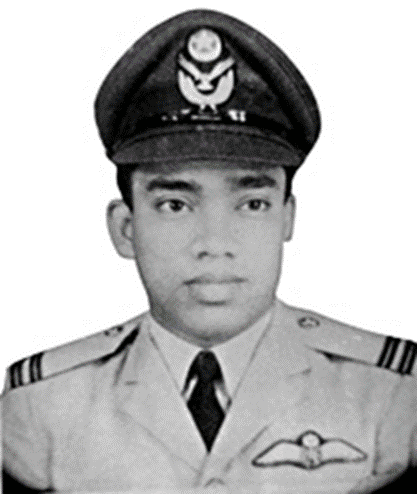The Bir Sreshtho (Bengali: বীরশ্রেষ্ঠ; The Most Valiant Hero), is the highest military award of Bangladesh. It was awarded to seven freedom fighters who showed utmost bravery and died in action for their nation. They are considered martyrs. The other three gallantry awards are named, in decreasing order of importance, Bir Uttom, Bir Bikrom and Bir Protik. All of these awards were introduced immediately after the Liberation War in 1971.
Gallantry Awards
3. Bir Bikrom
4. Bir Protik
Besides, there were some other awards like Independence Day Award, Bangladesh Freedom Honour, Bangladesh Liberation War Honour, and Friends of Liberation War Honour.
The Bir Srestho Award
The Bir Sreshtho (The
Most Valiant Hero), is the highest military award of Bangladesh.
It was awarded to seven freedom fighters who showed utmost bravery and died in
action for their nation.
• Sepoy Hamidur Rahman.
• Sepoy Mostafa Kamal.
• Engine room Artificer Ruhul Amin.
• Flight Lieutenant Matiur Rahman.
• Lance Naik Munshi Abdur Rouf.
• Lance Naik Nur Mohammad Sheikh.
Bir Srestho Shahid Captain
Mohiuddin Jahangir
Early Life :
Bir Srestho Mohiuddin Jahangir was born on 7 March 1949 in the village of Rahimgonj under Babugonj Upazila of Barisal.
His primary education was at the
Patarchar Primary School in Muladi. He passed his SSC examination from
Muladi Mahbudjan High School in 1964. He finished his HSC from the Barisal BM
College in 1966. In 1967 he enrolled at the department of Statistics at
the University of Dhaka.
Involvement in the war:
In 1971 Mohiuddin Jahangir was
working at the construction field at Karakoram. On 10 June 1971, he took a
few days leave and went back to Risalpur. A day later, he started towards
the Sialkot border to reach India. He managed to cross the border and
joined the Mukti Bahini at Mehdipur under Malda district in
West Bengal.Mohiuddin Jahangir was made the captain of a team in order to take
control of Chapai Nawabganj from the Pakistanis. He set his camp at a
place called Barghoria at the west of Nawabganj on 10 December. On 13 December
Mohiuddin Jahangir divided his force into three groups in order to attack enemy
camps at Chapai Nababganj and Rajshahi. One team, led by Lieutenant Rafiq,
crossed Mohananda and proceeded towards Rohonpur-Nachole-Anupura and Nawabganj.
The second team crossed the Mahananda River and marched towards the
city. At this point Mohiuddin Jahangir failed to establish any advantage over
the enemy, so he continued with his team and crossed Mahananda and camped at
Rehaichar before dawn. He intended to destroy one of the light machine gun
bunkers of the Pakistan Army and crawled towards it. He managed to get close to
the bunker and threw a grenade, but was shot dead a bullet hit his forehead
from another house roof.
Legacy
Bir shreshtha Shaheed Captain
Mohiuddin Jahangir College at Swarupnagar was named after him. The main gate of
Dhaka Cantonment, "Shaheed Jahangir Gate", is named in his honour.
Also, a college called Mohiuddin Jahangir College was named after him as well.
Bir Srestho Shahid Sepoy
Hamidur Rahman
Bir Srestho Hamidur Rahman was
born on 2 February,1953 in Khardo Khalishpur village in Moheshpur
thana of the Jhenaidah District. Rahman was killed on 28 October 1971
at Dholoi during the Battle of Dhalai, Srimangal during an
attempt to capture the Pakistani Army's position.
Involvement in the war:
Hamidur Rahman joined East
Bengal Regiment on 2 February 1971 and participated in the 1971 Bangladesh
Liberation War. During the war he made a significant contribution in
capturing the Dhalai Border Outpost at Srimangal. Though the independence
fighters came very close to the Border Outpost, it became very difficult to
capture owing to the enemy machine gun which was continuously firing from the
south-western corner of the Dhalai Border Outpost. On 28 October 1971, a
battle was taking place between 1st East Bengal Regiment and 30 A Frontier
Force Regiment in Dhalai of Sylhet. 125 members of the East Bengal
Regiment decided to use grenades on the machine gun posts of the
Pakistani army. Rahman took the responsibility of throwing grenades, and
crawled through the hilly canals.
He managed to throw two grenades
before he was shot.Rahman jumped into the enemy machine gun post and engaged in
hand-to-hand fighting with the two crews who were guarding the gun, and at one
point neutralised the gun. Realizing the fact that the machine gun outpost was
damaged, the EBR's approach towards the enemy captured their first line within
a short period of time. After the capture of the Dhalai Border Outpost, members
of the EBR found the dead body of Rahman. Rahman's efforts helped the East
Bengal Regiment take the outpost. He was buried in Tripura in India. On 27
October 2007, advisers of the Bangladeshi caretaker government decided to
bring back his remains to Bangladesh and bury him besides Bir
Shrestho Matiur Rahman.
Legacy
Bir Shreshtha Hamidur Rahman
Stadium in Jhenaidah district is named after him. A library and museum was
built in his memory . Hamidur Rahman Degree College was named in his
honour.
Bir Srestho Shahid Sepoy Mostafa kamal
Bir Srestho Mostafa Kamal was born on 16 December 1947 in Hajipur village
of Daulatkhan upazila under Bhola district. His father, Habibur Rahman was a
Havilder. On 18 April 1971, Muhammad Mustafa was killed in a defensive battle
against the Pakistan Army in Daruin village
of Brahmanbaria.
Kamal had his education only up to second grade and spent most of his childhood with his father at the Comilla Cantonment. On 16 December 1967, Kamal escaped from his house and joined the East Bengal Regiment.
Involvement in the war:
Muhammad Mostafa was a Sepoy of
the 4th East Bengal Regiment. At the start of March, the 4th Regiment was moved
from Comilla Cantonment to Brahmanbaria. After the incidents of 25
March, the 4th Regiment successfully brought Brahmanbaria under control. Under
the leadership of Major Shafayat Jamil, they revolted against the Pakistani
officers and formed a defense Camp at Brahmanbaria. They continued fighting
against the Pakistan Army and eventually arrived at Aakhaura. At Aakhaura, the
4th Regiment set their camp in Gangashagar and Talshahar. To avoid any
unexpected attacks from the Pakistanis, the 2nd Platoon of the company
"Alpha" was sent to Darwin village. Mostafa Kamal was one of the
section commanders of the 2nd Platoon.
On 16 April, Pakistan Army
started to approach the Regiment camp. They were coming over the railway of the
Comilla-Aakhaura root. The regiment also reconciled their position at Darwin.
They settled on their trenches near a pond. Mostafa took the rightmost
position.
On 17 April, Pakistanis opened
fire. Major Shafayat Jamil strengthened his force by sending the 11th Platoon
of company Delta to Darwin. At around 12 pm, the Pakistanis attacked from
West. Another part of the Pakistan Army attacked Mukti Bahini from behind.
As a result, the Regiment decided to retreat from Darwin. Mostafa Kamal took
the responsibility of covering for his fellow fighters. Most of the fighters
retreated to a safer position as Kamal relentlessly kept firing with
his light machine gun. He kept on fighting until he ran out of bullets and
was surrounded. He, along with 20 to 40 other Mukti Bahini soldiers, was
killed in this battle.
Legacy
In Kamalpur, a football stadium
named Bir Sreshtho Shaheed Sipahi Mohammad Mostafa Stadium was named
after him.
Bir Srestho Shahid Mohammad Ruhul Amin
Bir Shrestho Ruhul Amin was born in 1935 at Bagpanchra village under what is now Sonaimuri Upazila of Noakhali district. He was killed on 10 December 1971 while onboard BNS Palash which was sunk in reportedly an accidental fire by Indian Air Force
Involvement in the war:
At the start of Bangladesh
Liberation War with Operation Searchlight, Amin immediately resigned from
the Pakistan Navy, left PNS Comilla at Chittagong, and
returned to his village.He organized local youths and soldiers for the war. In
May, he along with 500 others joined at Sector-3 under Major K M
Shafiullah. Later he enrolled at Palash, a warship of Bangladesh
Navy and at the same time worked as the squadron leader for both Padma and Palash.
On 10 December 1971, during the
concluding days of the Bangladesh Liberation War, an incident occurred at the
Rupsha river in Khulna. In a successful campaign of the allied Bangladesh
and Indian naval forces, after freeing Jessore, the ships were advancing
towards capturing the Titumir naval base from the Pakistan Navy. Two of the
warships of the Mukti Bahini named Padma and Palash mistakenly
came under fire from the Indian Air Force as it crossed the river Rupsha near
the Khulna shipyard.
According to some other
witnesses, Indian Air Force fired at different places of Khunla city earlier
that day and incidentally one of those bombs had fallen at the warship Palash.
Ruhul Amin was working as an artificer of that ship. Both ships caught fire.As
a result of heavy bombing, the engine room in the warship caught fire and in a
bid to save the ship, Ruhul Amin tried to extinguish it, ignoring orders to
abandon the ship. But the engine room was under fire again and another shell
exploded which injured Ruhul Amin and made him to abandon the ship. He jumped
into the water and swam ashore but was attacked and killed with bayonets by the
awaiting Razakars.
Legacy
The Bangladesh Navy
warship BNS Shaheed Ruhul Amin is named after
him. Bir Shrestha Ruhul Amin Sarani is a road in Saidpur
cantonment, Saidpur, Nilphamari which is named after him.
Bir Srestho Shahid Flight
Lieutenant Matiur Rahman
Bir Srestho Matiur Rahman was
born in 29 October, 1941 in Narsingdi,Dhaka.
Bir Srestho Matiur Rahman completed his primary education at Dhaka Collegiate School. After that, he was admitted into Pakistan Air Force School Sargodha in West Pakistan.
Involvement in the war:
Matiur Rahman was an instructor
pilot at PAF Base Masroor in 1971. He was planning to defect to
Bangladesh with a plane to join the Bangladesh Liberation War. On 20 August
1971, Pilot Officer Rashid Minhas was scheduled to fly with
a Lockheed T-33 jet trainer. Rahman saw Minhas about to take off and
asked to join him, he jumped into the instructor seat.He attempted to hijack
the T-33 in midair from Karachi, Pakistan to India to join the liberation
movement. Minhas sent a message to the control tower that he has been hijacked.
Minhas wrestled with Rahman for control and crashed the plane in Pakistan's
territory which caused the death of both pilots. The plane never crossed into
India's airspace and crashed near the border in Pakistan.
After over 30 years of
negotiations, Rahman's body was finally returned to Bangladesh on 24 June 2006
for a ceremonial and highly symbolic reburial in 2006. He was buried at the
Martyred Intellectuals Graveyard, in Mirpur, Dhaka, with full military honours
Legacy
Bangladesh Air Force Base Matiur
Rahman at Jessore is also named after him. Bangladesh Air Force also gives
out a trophy named after him for best performance in the flying training.
Bir Srestho Shahid Lance Naik Munshi Abdur Rouf
Munshi Abdur Rouf was born on 8 May 1943 at Salamatpur village. Rouf died on 20 April 1971 at Burighat in Chittagong Hill Tracts after causing extensive damage to the Pakistani Army with his machine gun and forcing them to retreat.
Involvement in the war:
On 8 April 1971, the Pakistani
Army attacked the Mukti Bahin is defensive position with 7 speed
boats and 2 launches. Their mission was to drive the Mukti Bahini away from the
waterway of Rangamati and Mohalchari. Pakistani forces managed to disorient
Mukti Bahini by coming closer to them and firing heavily. In the meantime
Pakistanis surrounded the freedom fighters and managed to isolate nearly 100 of
them. Rouf realised the threat to the entire company. So, he crawled forward to
his trench and continuously fired towards the enemies with his automatic
machine gun. As a result, the Pakistanis dragged their launches back to a safer
place and resumed firing from there. Suddenly a mortar hit Rouf directly
and he was immediately killed. Rouf's valiant effort helped his company to
survive as his act saved nearly 150 soldiers of the Mukti Bahini on that day.
Legacy
A cricket stadium has been named
is Sylhet after him.A college in Faridpur was named after him.
Bir Srestho Shahid Lance Naik Nur
Mohammad Sheikh
Bir Srestho Nur Mohammad Sheikh was born on February 26, 1936, in Moheshkhali village Narail . He was killed in an engagement with the Pakistan Army while providing covering fire for the extrication of fellow soldiers at Goalhati in Jessore district on 5 September 1971.
Involvement in the war:
On 14 March 1959, Sheikh joined the East Pakistan Rifles. After
finishing elementary training, he was appointed at
the Dinajpur sector.He was transferred to Jessore sector on
1 July 1970. Lance Nayek Nur Mohammad was selected as the captain of the
Standing Patrol team at Goalhati in Jessore's Chutipur Camp that was
established to monitor the Pakistan army. On 5 September, Nur Mohammad was
patrolling with 4 fellow soldiers. The Pakistan army attacked them from three
different sides. Nur Mohammad tried to retreat to his base while still engaging
the Pakistani troops. Meanwhile, one of his fellow soldiers, Nannu Mia, was
injured after a bullet hit him. Nur Mohammad tried to carry Nannu Mia towards
safety while trying to fire his gun from different places as a trick to confuse
the Pakistani troops into believing that there were more than four Bangladeshi
rebels. In doing so, Nur Mohammad himself was hit by a mortar and his
foot was destroyed. Even though he was seriously injured, Nur Mohammad decided
to continue to provide cover fire for his team to escape. At the time, his
fellow Sepoy Mostafa urged Nur Mohammad to go with him. Mostafa even tried to
force Nur Mohammad to go but Nur Mohammad refused to go and gave his light
machine gun to Mostafa so that it would not be captured after his death. He
kept a self loaded rifle with him and kept on fighting until he died
Legacy
Bir Shreshtha Noor Mohammad Public College at Pilkhana has been named in his memory.

